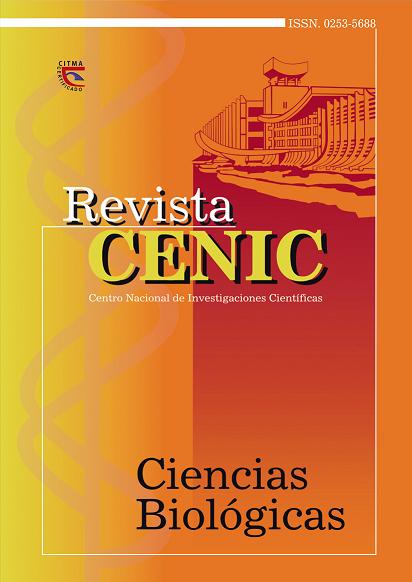Antifungal effect of an extract of Petiveria alliacea L.
Abstract
Petiveria alliacea’s utilities as antimicrobial agent have been reported by different authors. The aim of this
work was to study the antifungal effect of a hydroalcoholic extract of this plant (HAEPAL) on 11 yeast strains (Candida
albicans ATCC 64548 and ATCC 64550 C. krusei ATCC 6258, C. glabrata ATCC 90030, C. lusitaniae ATCC 200951, C.
parapsilosis ATCC 22019, Saccharomyces cerevisiae ATCC 9763, Rhodotorula mucilaginosa LMIPK 0282, Trichosporom
asahii LMIPK 0293, Cryptococcus neoformans var. grubii LMIPK 0291 y LMIPK 0292). The antifungal effect against these
species has not been reported before. The in vitro antifungal activity of HAEPAL was evaluated by diffusion and dilution
procedures. Final concentration of the strains in the medium (Sabouraud-dextrose with HAEPAL at 0, 0.5, 2.5, 5, 7.5 and
10 %) was 0.5 · 103 cells · mL–1. The minimal inhibitory concentration (MIC) was defined as the lowest concentration of
the extract that inhibited at least half of the growth compared with the growth control for each strain. HAEPAL 10 %
completely inhibited 9 of the 11 studied strains, while a total of six were inhibited by the extract at 7.5 %. All the studied
species reached their MIC50 value with HAEPAL at 5 and 7.5 %. Inhibition activity of lower concentrations of the
extract was very weak. A significant in vitro inhibitory effect of P. alliacea extract on the studied yeasts was observed.
These results suggest a potential use of the evaluated extract as antimycotic treatment.
Downloads

Downloads
Published
How to Cite
Issue
Section
License

This work is licensed under a Creative Commons Attribution-NonCommercial-ShareAlike 4.0 International License.
Los autores que publican en esta revista están de acuerdo con los siguientes términos:
Los autores conservan los derechos de autor y garantizan a la revista el derecho de ser la primera publicación del trabajo al igual que licenciado bajo una Creative Commons Atribución-NoComercial-CompartirIgual 4.0 Internacional que permite a otros compartir el trabajo con un reconocimiento de la autoría del trabajo y la publicación inicial en esta revista.
Los autores pueden establecer por separado acuerdos adicionales para la distribución no exclusiva de la versión de la obra publicada en la revista (por ejemplo, situarlo en un repositorio institucional o publicarlo en un libro), con un reconocimiento de su publicación inicial en esta revista.
Se permite y se anima a los autores a difundir sus trabajos electrónicamente (por ejemplo, en repositorios institucionales o en su propio sitio web) antes y durante el proceso de envío, ya que puede dar lugar a intercambios productivos, así como a una citación más temprana y mayor de los trabajos publicados (Véase The Effect of Open Access) (en inglés).














